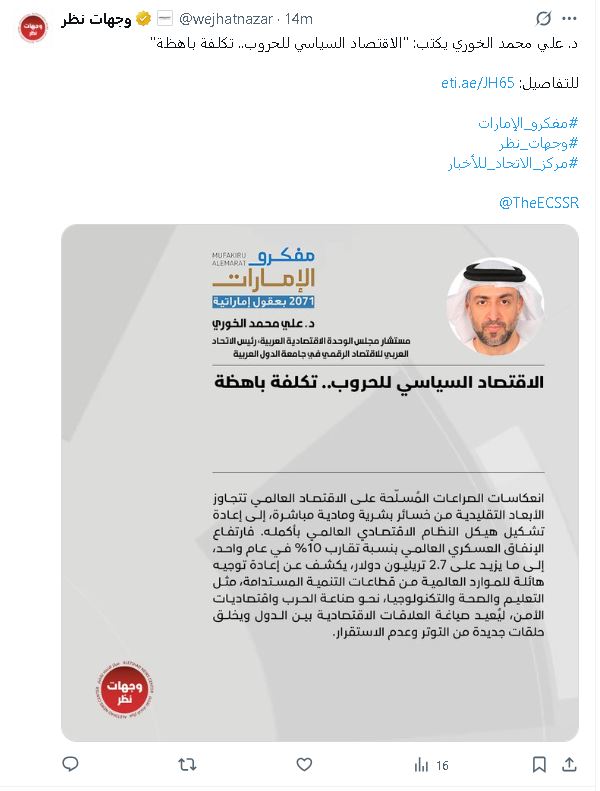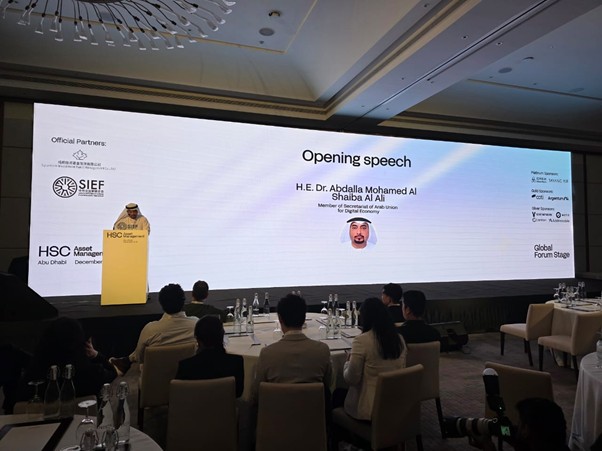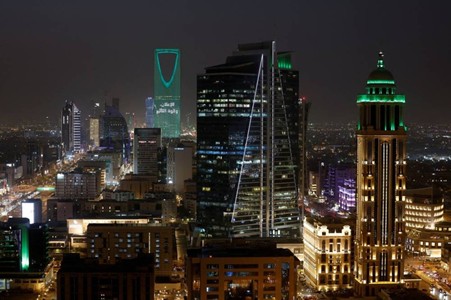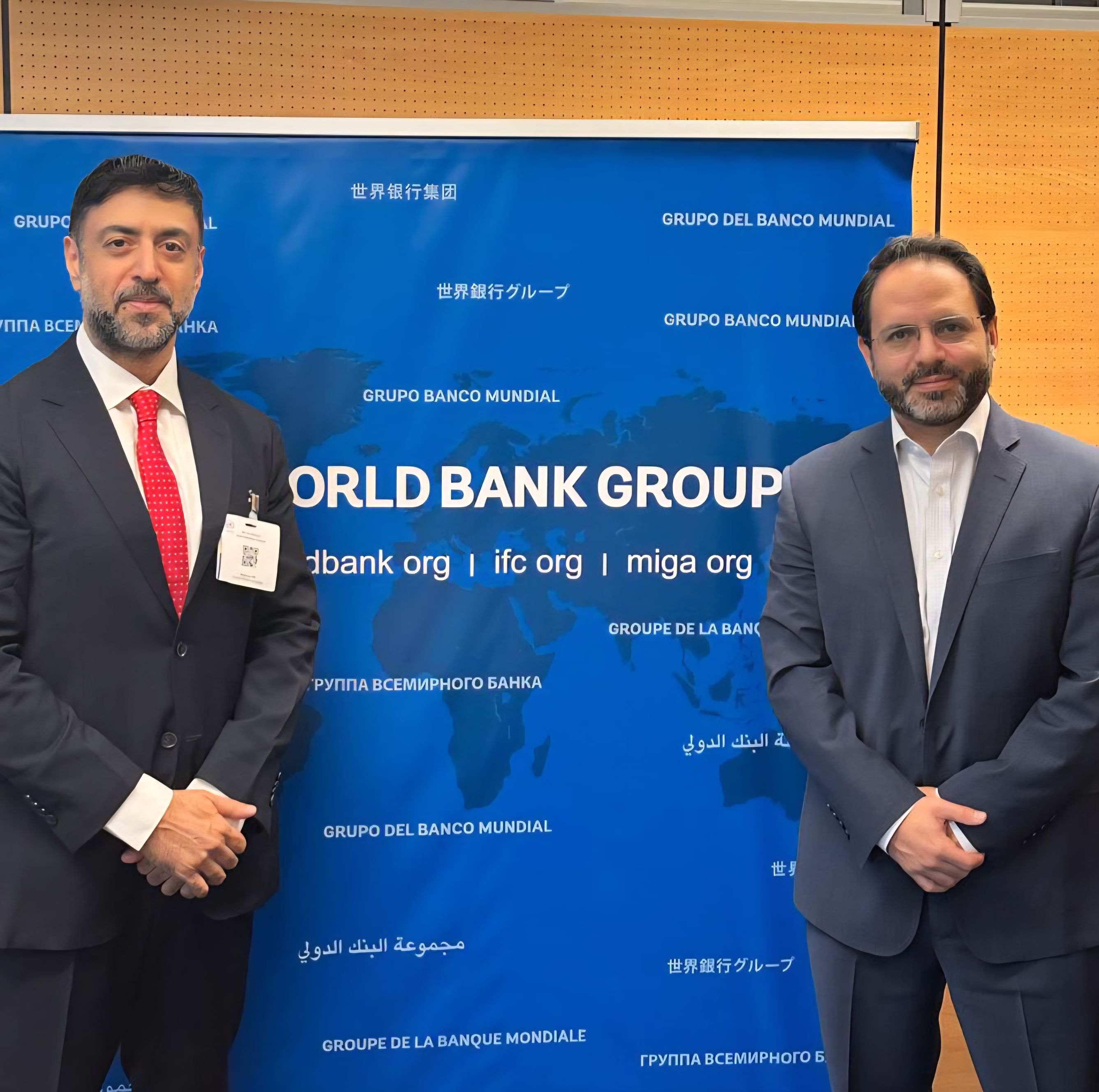Abu Dhabi
Source: Alittihad Newspaper
Mufakiru Alemarat
Prof Dr. Ali Mohammed Al Khouri
In recent years, the human and economic costs of military operations and engagements have escalated to unprecedented levels, making wars a structural force ravaging global economies and threatening the collapse of the remaining foundations of security and political and social stability in affected regions and countries, especially those whose foundations of resilience are nearly exhausted. Given this reality, the world is entering a new phase of protracted wars, in which political interests intertwine with economic and social crises in a complex manner, with their impacts extending far beyond the immediate battlefields. The most significant issue is that these crises have led to the emergence of an international system shrouded in economic and strategic ambiguity and uncertainty. Wars and armed confrontations have become a structural reality in the global economy, casting a shadow over development opportunities and preparing the world for a new phase of economic risks and fluctuations. Unprecedented Economic Burdens: Figures and statistics from the Global Peace Index indicate that the economic cost of violence reached approximately $20 trillion in 2024, representing more than 11% of the global gross domestic product (GDP), clearly reflecting the inability of the current international system to contain conflicts and address complex security crises. From a broader perspective, the economic repercussions go beyond limited regional unrest to threaten the infrastructure of the entire global economy.
Conflicts that erupted in vital strategic regions, such as the Red Sea and the Strait of Hormuz, have led to widespread disruptions to energy flows and international trade routes, causing significant increases in shipping costs and compounding existing economic burdens. As a natural consequence, successive waves of “complex inflation” have emerged—a dangerous combination of economic recession and rising prices, threatening the stability of both developed and developing economies.
The continuity of military confrontations and their transformation into recurring phenomena indicates the transformation of conflicts from temporary situations into a permanent structural reality, in which the wheel of war moves as an active force, reshaping international relations, and directly impacting and continually reshaping the trajectories of the global economy. Wars as a New Political Economy This reality reaffirms the view of the strategic thinker Carl von Clausewitz, one of the most prominent military theorists in modern history, when he described war as “the extension of politics by other means.” By this, he meant that wars, in reality, are not separate events or stand-alone objectives, but rather political means to which states resort to achieve their strategic goals when diplomatic and negotiating options fail.
However, the world today is witnessing a reality that far exceeds this classical conception, presented by Clausewitz two centuries ago, and which today finds deeper credibility. Wars are no longer mere means used in special circumstances, but have transformed into the essence of politics itself, the primary driver of the economy and international relations, and an enduring structural force that continually reshapes the system of international interests and balances. This makes wars in our current era a strategic reality that permeates the heart of global politics, not merely complementary tools. The Human Tragedy: Current economic data cannot be read in isolation from the painful humanitarian landscape that accompanies them. Last year, the world recorded the deaths of more than 152,000 people, the highest number recorded in a single year since World War II.
Meanwhile, more than 120 million people live in dire conditions as refugees or internally displaced persons, transforming the global displacement crisis into a protracted humanitarian tragedy. This crisis contributes to the exacerbation of social and economic crises in host countries, places significant pressure on their resources, and threatens their ability to protect their social unity and internal stability. The severity of these humanitarian conditions increases with the continuation of armed conflicts and the intensification of the resulting economic pressures. The repercussions are no longer limited to threatening human lives; their effects extend to undermining political and social stability in affected countries and regions, especially those that lack even the bare minimum of resilience and survival.
The Global Economy Under the Sway of Militarization If we broaden our perspective to understand what is happening, the repercussions of armed conflicts on the global economy go beyond the traditional dimensions of direct human and material losses to reshaping the entire structure of the global economic system. The nearly 10% increase in global military spending in a single year, to over $2.7 trillion, reveals a massive redirection of global resources from sustainable development sectors, such as education, health, and technology, toward the war industry and security economies. This reshapes economic relations between countries and creates new cycles of tension and instability.
At the regional level, Europe stands out as a clear example of the significant economic cost of protracted wars. European military spending has increased by 17%, reaching nearly $700 billion—a level unprecedented since the end of the Cold War—driven primarily by the ongoing war in Ukraine and escalating geopolitical tensions with Russia.
Concurrently, the Middle East also witnessed new record levels in military spending, reaching $243 billion in 2024, a 15% increase compared to 2023. The Gulf states expanded their military investments through deals worth approximately $142 billion, encompassing advanced fields such as artificial intelligence and modern security technologies. These figures clearly reveal the contours of a new world order characterized by increasing militarization and reflect governments’ tendency to invest strategically in armaments as a precautionary and preventative measure in anticipation of potential fluctuations and tensions at the regional and international levels.
However, despite its preventive motives, this step is a dangerous indicator of the declining focus on economic and social development priorities on national agendas, given a complex international context in which political, economic, and security risks overlap. How crises are exploited to create new economic opportunities: This contrasts the political-economic thesis of “shock doctrine,” which suggests that certain powers exploit wars and major crises to disrupt societies and impose economic and political changes difficult to accept in normal times, such as market liberalization, privatization of public assets, or reshaping the social order to benefit certain groups. The concept of “political economy of conflict,” which highlights how conflicts and wars have today become deliberate strategic tools for reshaping local economies and distributing influence and control over economic and political resources among international powers, is highlighted by critical studies in political economy. War has become a “shock” that opens the door to transformation.
If we turn to today’s unstable countries, such as Ukraine, Gaza, and other hotspots of conflict, it becomes clear how these regions have become living laboratories for testing the global system’s ability to contain and deal with major crises. Ukraine today faces a reconstruction bill estimated at nearly three times the size of its annual economy, leaving it in a state of constant dependence on external aid. Meanwhile, the Gaza Strip is suffering from a near-total economic collapse, with unemployment rates soaring to record levels exceeding 90%, rendering it unable to secure the minimum requirements for development or even economic recovery. To explain this situation more clearly, the theory of the prominent economist Paul Collier, put forward in his book “The Bottom Billion,” seems profoundly significant, as it highlights how societies and economies are trapped in “traps.” The theory is based on the fact that nearly one billion people living in approximately 60 countries are unable to achieve economic growth despite global development efforts.
Collier believes that countries that become mired in the vortex of armed conflict and strife not only lose their resources and economic opportunities in the short term, but also become trapped in vicious cycles of persistent economic decline and increasing reliance on foreign aid and international loans. This leads to increased poverty and dependency, entrenches weak domestic institutions, and prevents the emergence of a truly developmental environment. The experiences of Ukraine and Gaza confirm that breaking out of these vicious cycles is neither easy nor possible with emergency aid. Rather, it requires long-term international intervention and profound institutional reforms aimed at breaking the “trap” and effectively and sustainably reintegrating these countries into the global economy.
Environmental Cost: On another level, the environmental crisis resulting from armed conflicts represents a challenge no less serious than the direct economic cost. The destruction of ecosystems is closely linked to other, more profound and complex problems, such as stifling economic crises, the intensification of social problems such as poverty and displacement, and the escalation of political tension between ruling regimes and societies. Therefore, addressing the environmental crisis requires a broader, more comprehensive approach that recognizes the interconnectedness and overlap between environmental, social, political, and economic dimensions.

According to a study from the University of Illinois in the United States, the environmental damage from the conflict in Ukraine alone amounts to approximately $56.4 billion by 2024. The data also indicates that armed conflicts are responsible for approximately 5.5% of total global carbon emissions, and that the Gaza War, through January 2025, generated emissions estimated at approximately 31 million tons of carbon dioxide.
These data confirm once again that partial or temporary solutions will not be sufficient to address the roots of the worsening crises in the world today. Peace as a foundation for economic development: In the face of these major challenges that are shaking the foundations of the global order and threatening to undermine the foundations of stability and development built over decades, decision-makers, particularly in the Arab world, must re-examine the concept of peace from a new perspective, one that goes beyond the traditional, narrow definition that limits peace to the absence of war.
To achieve this necessary shift, the concept of contemporary peace must first become a central strategic priority, formulated according to an unconventional political and economic vision, establishing a long-term preventive approach, and drawing on modern theories of international relations and political economy. This approach places peace as a structural pillar of the economic development process, rather than merely a security or moral goal. The War Economy and the Conflict Trap We must be aware of and draw on historical experiences, which confirm that societies dominated by armed conflict gradually lose their ability to achieve economic stability and development, becoming hostages to what is known in modern political economic theories as the “war economy,” where resources and capabilities are directed toward fueling conflicts rather than investing in development and construction. This reality only produces successive cycles of poverty and a chronic inability to achieve sustainable development. Soft Power Faced with this scenario, Arab countries are called upon today more than ever to translate the concept of peace into practical frameworks and policies that go beyond traditional political conventions. These policies must be based on the principle of “strategic prevention,” employing early warning and monitoring systems, adopting proactive diplomatic strategies, and strengthening regional and Arab institutions concerned with resolving and settling conflicts before they ignite or expand. This approach clearly translates the theory of “soft power,” which emphasizes the effectiveness of diplomatic, cultural, and economic tools in resolving international disputes more effectively than traditional military means. The Developmental State: In a related context, Arab countries need to restructure their national economic systems in accordance with the concept of the “developmental state.” This concept positions the state as an effective leader in leading development and achieving economic and social stability through economic policies that combine governance and responsible management, human resource development, and increased national productivity. This approach provides countries with an opportunity to restore ties between society and state institutions and to restore social trust, which is the cornerstone of any genuine renaissance project.

It also prepares these countries for the possibility of gradually liberating themselves from chronic economic and political dependence and subordination, enabling them to take the lead in shaping their economic and political future, free from external influence. Environmental Economy: Within the context of this comprehensive vision, it is important that the institutional structure of countries suffering from the effects of internal conflicts and strife be accompanied by a qualitative shift in how they deal with the environmental crises caused by these conflicts. Here, decision-makers in the Arab world must adopt the approach of “environmental economics” from its contemporary perspective, which requires the inclusion of natural and environmental resources as a fundamental element in countries’ economic and strategic calculations. The experience of contemporary conflicts has proven that the environment has become a direct victim of wars, and that environmental destruction now imposes a heavy economic cost that undermines future development prospects. Therefore, the design of reconstruction budgets and plans must include the environmental dimension, so that natural capital is rebuilt as part of the rebuilding of human and social capital. Development Investment Funds: At the practical and applied level, policy recommendations directed at decision-makers in the Arab world must crystallize into concrete, strategic initiatives. These include, for example, the establishment of joint regional funds dedicated exclusively to investing in peace and sustainable development, financed by diverting a measured percentage of military spending to support vital sectors such as education, technology, innovation, and youth empowerment.
Such funds would contribute to building more resilient and economically and socially resilient Arab societies, better able to deal effectively with internal and external challenges and crises, and establish a stable and effective regional system within the contemporary international landscape. Preventive Development Alliances At the diplomatic level, Arab countries are called upon to reformulate the concept of “regional alliances” from a strategic perspective that transcends traditional frameworks that have limited relations between countries to competition, confrontation, or narrow alignments that serve temporary interests.
These alliances, which can be termed “preventive development alliances,” should establish new spaces for long-term economic and development cooperation, such as shared infrastructure, economic integration, and trade exchange, rather than being mere temporary alliances based on immediate political balances or positions. Furthermore, these new partnerships must be based on realistic interests and mutual benefits between countries, far removed from the language of slogans or traditional political rhetoric that no longer meets the needs of the current era.
The Arab Future: In brief, the Arab world stands at a historic precipice, facing two choices: either remain in the shadow of the never-ending crises of the past, or embark on a path toward shaping a future characterized by hope and construction. The true peace sought by the Arab peoples will not be built by the absence of war, but rather by building the human being, advancing society, and upholding human dignity as a pillar of development. This requires the courage and will to break the vicious cycle linking war and economics. Only these countries will be able to chart their future and define their position and role within the new global order.












